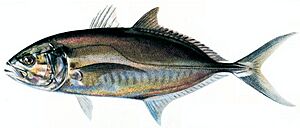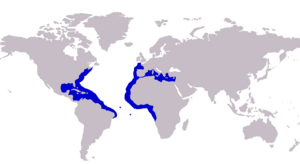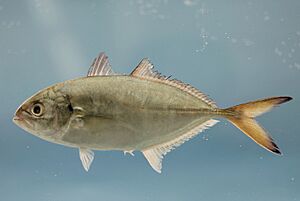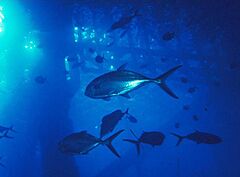Blue runner facts for kids
Quick facts for kids Blue runner |
|
|---|---|
 |
|
| Conservation status | |
| Scientific classification | |
 |
|
| Approximate range of the blue runner | |
| Synonyms | |
|
The blue runner (Caranx crysos) is a common and moderately large ocean fish. It belongs to the jack family, called Carangidae. You might also hear it called the bluestripe jack, Egyptian scad, hardtail jack, or hardnose.
Blue runners live all across the Atlantic Ocean. You can find them from Brazil to Canada in the western Atlantic. In the eastern Atlantic, they range from Angola to Great Britain, including the Mediterranean Sea. This fish can grow up to 70 cm (about 27 inches) long and weigh over 5 kg (11 pounds). However, most blue runners are smaller, usually less than 35 cm (14 inches).
These fish live in both coastal areas and deeper ocean waters. They often gather around reefs and large structures like oil platforms. Young blue runners prefer shallower waters, like reefs and lagoons. As they grow older, they move to deeper parts of the ocean. Blue runners are predators, meaning they hunt other animals. They often eat smaller fish and crustaceans. Fish living far offshore mostly eat tiny ocean creatures called zooplankton.
Blue runners are important for fisheries, with thousands of tonnes caught each year. They are also popular with anglers (people who fish for sport). Anglers enjoy catching them on light fishing gear. Sometimes, blue runners are used as bait for bigger fish. They are not considered the best fish to eat.
Contents
Discovering the Blue Runner
The blue runner is part of the Caranx genus, which includes many types of jacks and trevallies. This genus is part of the larger Carangidae family.
First Scientific Description
The first scientific description of the blue runner was made in 1815. An American ichthyologist (fish scientist) named Samuel Latham Mitchill described it. He found a specimen in New York Bay, USA. Mitchill named the species Scomber crysos. The name crysos means "gold" in Greek, which he used because he called it the 'yellow mackerel'.
Over time, the blue runner has been given other scientific names. Some of these include Caranx fusus and Caranx pisquetus. However, these names are now considered incorrect. The correct scientific name today is Caranx crysos. Besides 'blue runner', it has many common names. These include 'bluestripe jack', 'Egyptian scad', and 'hardtail jack'.
Similar Species
Scientists have wondered if the blue runner is the same species as the green jack (Caranx caballus). The green jack lives in the eastern Pacific Ocean. Recent genetic studies show these two species are very closely related. However, it is still not fully decided if they are the same.
What Does a Blue Runner Look Like?
The blue runner has a long, somewhat flattened body. Its top and bottom parts are equally curved. The snout is slightly pointed. The back of its eye is partly covered by a fatty eyelid. Its jaw extends to just below the center of its eye.
Fins and Scales
The dorsal fin (on its back) has two parts. The first part has 8 stiff spines. The second part has 1 spine and 22 to 25 soft rays. The anal fin (on its belly) has 2 detached spines at the front. Then it has 1 spine and 19 to 21 soft rays. The pectoral fins (on its sides) become more curved as the fish gets older. They have 21 to 23 rays and are a bit longer than the head.
The lateral line (a sensory line along its side) has a short, curved part at the front. The straight part has 0 to 7 scales followed by 46 to 56 very strong scutes (bony plates). The entire lateral line has 86 to 98 scales and scutes. The chest area of the fish is fully covered in scales.
Teeth and Gills
The upper jaw has an irregular row of outer canine teeth. Inside, there is a band of small, evenly spaced teeth. The lower jaw has a single band of small teeth. The blue runner has 35 to 42 gill rakers (finger-like projections on its gills). These help it filter food from the water.
Coloration
The color of a blue runner can vary. Its back is usually bluish-green to olive-green. Its belly is silvery-grey to brassy. Young blue runners often have 7 dark vertical stripes on their bodies. Their fins can be dusky, clear, or olive-green. They also have a dark spot on the upper part of their gill cover.
Where Do Blue Runners Live?
Blue runners are found in tropical and temperate waters of the Atlantic Ocean. They live along the eastern coasts of the Americas. They are also found along the western coasts of Africa and Europe.
Western Atlantic Range
In the western Atlantic, they are found as far south as Maceio, Brazil. They range north along Central America and throughout the Caribbean Sea. Their distribution extends into the Gulf of Mexico and north along the U.S. coast. They can be found as far north as Nova Scotia in Canada. They also live around several islands in the northwest and central Atlantic.
Eastern Atlantic Range
In the eastern Atlantic, blue runners are found from Angola north along the west African coast to Morocco. They are common throughout the Mediterranean Sea, seen in almost all countries along its shores. They are rarely found north of Portugal. However, there have been isolated sightings near Madeira Island and Galicia, Spain. The furthest north they have been reported is southern Great Britain.
Scientists have noticed that blue runners and other tropical species are being found further north more often. This might be due to rising sea surface temperatures, possibly linked to climate change.
Blue Runner Homes
Blue runners mostly live near the coast, but they can also be found on reefs in waters deeper than 100 meters (330 feet). In some parts of Central America, they are more common on outer reefs than close to shore. They are often found near inshore reefs and the edges of deep reefs.
Young Fish Habitats
Young blue runners often live in shallow waters of coastal lagoons. They find shelter around mangroves or in seagrass beds near coral reefs. They have also been found in the Mississippi delta, meaning they can handle water with lower salt levels, like in estuarine environments.
Attracted to Structures
Blue runners are easily drawn to large underwater or floating objects. Studies show they gather around floating fish aggregating devices (FADs). They do this in both shallow and very deep waters (up to 2500 meters or 8,200 feet). When around FADs, blue runners form small groups near the water surface.
Large numbers of blue runners gather around oil and gas platforms in the Gulf of Mexico during warmer months. They change their feeding habits to use these structures. Man-made artificial reefs and aquaculture cages also attract them.
Blue Runner Life and Habits
Blue runners usually move in small schools or alone. However, sometimes huge groups of up to 10,000 fish have been seen. In some areas, like Santa Catarina Island, they are one of the most common fish species. Scientists have studied their reproduction and growth a lot. This is because they are so common and important to fisheries.
What Blue Runners Eat
The blue runner is a fast-swimming predator. It mainly eats small fish that live on the seafloor in coastal waters. Studies in places like Puerto Rico and Cape Verde show similar diets. Besides fish, they eat crabs, shrimps, copepods, and other small crustaceans. They also eat prawns, lobsters, and even jellyfish.
Young blue runners mostly eat zooplankton, especially tiny copepods. As they grow, they start eating more fish. Adult blue runners living offshore or around oil platforms eat less fish. Instead, they feed a lot on larger zooplankton during the summer. This includes larval decapods, stomatopods, and small fish.
Blue runners around platforms feed day and night. They prefer larger prey like fish at night. Smaller crustaceans are eaten during the day. Blue runners sometimes hunt in schools alongside spinner dolphins. They take advantage of any food scraps left by the dolphins. They have even been known to eat dolphin waste. Blue runners are important predators, but they are also food for many larger species. These include bigger fish, birds, and dolphins.
How Blue Runners Reproduce and Grow
Blue runners become ready to reproduce at slightly different sizes. In Florida, they mature at about 267 mm (10.5 inches). In Louisiana, females mature at 247–267 mm (9.7–10.5 inches) and males at 225 mm (8.9 inches). In Jamaica, females mature at 280 mm (11 inches) and males at 260 mm (10.2 inches).
They seem to lay eggs offshore all year round. However, there are peak times for spawning. In the Gulf of Mexico, the main spawning season is from June to August. A female blue runner can release between 41,000 and 1,546,000 eggs. Larger fish produce more eggs. Both the eggs and the newly hatched larvae float in the open ocean.
Young blue runners have a slightly shallower body than other young Caranx fish. They also have a lot of dark color on their head and body. Very young fish have several clear dark vertical stripes on their sides. Larvae and small juveniles stay offshore. They live at depths of about 10 to 20 meters (33 to 66 feet). They also gather around floating objects, like Sargassum seaweed mats and large jellyfish. As they grow, they move to coastal lagoons and reefs. Then, as they get ready to reproduce, they slowly move to deeper outer reefs.
In all studies, there are more female blue runners than males in the adult population. The oldest known blue runner lived to be 11 years old.
Blue Runners and People
The blue runner is a very important fish for commercial fisheries in many areas. Because there are so many of them, they can be a main species caught by fishermen.
Commercial Fishing
In the Americas, the amount of blue runners caught has increased. In 2006 and 2007, catches averaged between 6,000 and 7,000 tonnes. This is much more than the 1,000 tonnes caught annually in the 1980s and 1990s. For example, in Santa Catarina Island, blue runners are the third most important species. They make up 5.6% of the total fish caught there.
Fishermen catch blue runners using various methods. These include haul seines, lampara nets, purse seines, gill nets, and hook and line. The fish are sold fresh, dried, smoked, or processed into fishmeal, oil, or bait.
Recreational Fishing
Blue runners are also very popular for recreational fishing. Anglers catch them for food or to use as bait. They are known as excellent gamefish on light fishing tackle. They will bite on fish baits and many types of lures. These include hard lures, spoons, metal jigs, and soft plastic jigs. They are also a target for fly fishermen.
The IGFA world record for a blue runner is 5.05 kg (11 lbs 2 oz). This fish was caught off Dauphin Island in 1997. Blue runners are often used as live bait for bigger fish. These include billfish, cobia, and amberjack.
Blue runners are not considered a high-quality table fish. Larger ones can sometimes carry a toxin called ciguatera in their flesh. Several cases of ciguatera poisoning from blue runners have been reported in the Virgin Islands.
Images for kids






